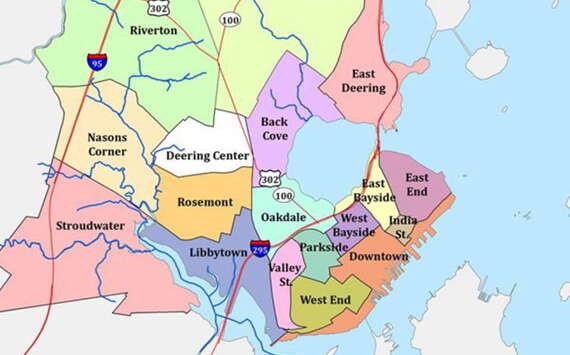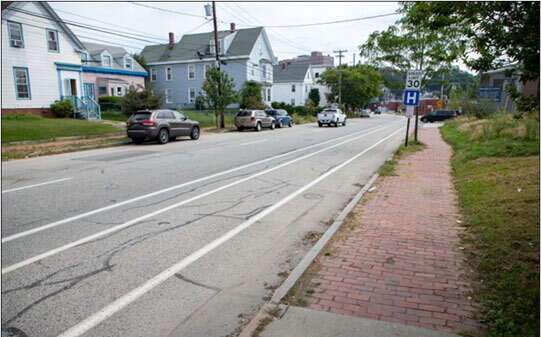
$22.4M in transportation improvements may help stitch together Portland’s Libbytown
 Photo / Andrea Tetzlaff
A former Denny's restaurant in Portland's Libbytown neighborhood was recently torn down to make way for traffic improvements.
Photo / Andrea Tetzlaff
A former Denny's restaurant in Portland's Libbytown neighborhood was recently torn down to make way for traffic improvements.
When Interstate 295 was built in the late 1960s, the Libbytown neighborhood was severed from the rest of Portland and construction displaced more than 15 businesses and 200 families. The highway and large cloverleaf interchanges cut off the area physically and created transportation and access barriers that still exist.
A $22.4 million grant, announced Monday, may help reverse some of those effects by fixing unsafe roads and sidewalks and improving access to housing, jobs, shopping, health care and recreation.
The money was awarded by the U.S. Department of Transportation’s Reconnecting Communities and Neighborhoods Program to the Maine Department of Transportation.
“For decades, the Libbytown neighborhood has been cut off from the rest of Portland and unfairly stunted by unsafe infrastructural barriers,” said U.S. Rep. Chellie Pingree, D-Maine 1st District, and an advocate for the project. “MaineDOT’s project will make Libbytown safer and will help reconnect the neighborhood with Portland’s growing community.”

Libbytown is one of Portland’s oldest neighborhoods.
Tavern-keeper George Libby and his descendants gave the area its name, having settled in the early 19th century at the intersection of Park and Congress streets, known as Libby’s Corner. The neighborhood was the center of a small but thriving business district.
Crashes and fragmentation
Residents and neighborhood organizations have been advocating for improvements since 2008, according to MDOT’s grant application.
That’s been driven in part by safety issues. From January 2020 through December 2022, there were 183 vehicle crashes, two bicycle-related and four pedestrian-related vehicle crashes in the area.
Interstate 295 was constructed to move large volumes of traffic to and from Interstate 95 to Portland’s urban core. Today I-295 carries 61,440 vehicles through Portland daily.

But in doing so, the highway slices through existing communities and neighborhoods. For Libbytown, the result was particularly significant, since the highway created two parts physically detached and isolated from much of Portland and each other.
Fragmentation and outdated street design resulted in a neighborhood burdened by traffic, safety concerns, transit inefficiencies and transportation limitations.
Minor infrastructure improvements have been undertaken periodically since the 1970s but the efforts were often disjointed. Today, pedestrian safety concerns and vehicle crashes are on the rise.
Although Libbytown is a gateway to Portland’s downtown peninsula, the neighborhood’s transportation infrastructure has been a challenge including lack of safe bicycle facilities, forcing cyclists to ride along narrow pavement edges or share limited sidewalk space with pedestrians.
Many sections of sidewalk are in disrepair and crosswalks are dangerous due to the lack of modern ADA features.
Outdated street design created issues around neighborhood connectivity, wayfinding, accessibility, recirculation, safety and pedestrian and bicycle travel.
Improve infrastructure
The plan includes transportation-related connectivity improvements:
- Provide modern and uniform multimodal connections to employment, retail, health care, tourism and recreation
- Expand safety and efficiency for motorists and active transportation users
- Improve response time for emergency services
- Implement multi-modal street design to improve active transportation and vehicle flow
- Expand the use of safe and convenient public transit
- Meet Americans with Disabilities Act and MaineDOT standards for transportation infrastructure
- Manage flooding and stormwater runoff
- Improve supply chains to support efficient “last mile” delivery of goods to Maine’s largest downtown.
Among the specifics is a plan to reconstruct the confluence of Congress Street and Park Avenue under Interstate 295. That will involve:
- Constructing a roundabout, including sidewalks and bike lanes, to slow vehicular traffic
- Installing consistent pedestrian infrastructure features, including sidewalks and crosswalks, throughout Congress Street and Park Avenue
- Providing high-quality bicycle infrastructure, separate from streets and sidewalks
- Building separated crosswalks for bikers and pedestrians
- Redesigning connections between interstate ramps and local streets to improve safety
- Increasing streetside greenspace.
Another piece involves restoring Park Avenue and Congress Street to two-way flow by:
- Reconstructing streets to restore bidirectional traffic flow with traffic-calming features
- Installing center turn lanes while avoiding the creation of additional traffic lanes
- Building modern transit stops that include shelters, benches, bike racks and electronic signage
- Installing sidewalks separated from the street by a tree-lined esplanade
- Creating two-way bike paths/cycle tracks separated by tree-lined esplanade
- Installing separate bike and pedestrian crosswalks
- Replacing railroad crossing signage at a busy at-grade crossing.
$100M benefit
The overall goal is to create multimodal infrastructure that will make the neighborhood collectively safer and restore Libbytown as a connection to the downtown.
The project is expected to significantly improve access to and the time it takes to access everyday destinations such as employment centers, schools, grocery stores and medical facilities, with affordable transportation connections and better public transit options.
An analysis provided by MDOT estimates there will be more than $100 million in total benefits resulting from a $31.5 million investment, which includes the $22.4 million grant and previously incurred expenses.
The are expected to arise from various sources, including safety improvements, ongoing maintenance cost savings, property value enhancements, reduced harmful emissions, increased active transportation and the value associated with bicycling facility improvements.








0 Comments